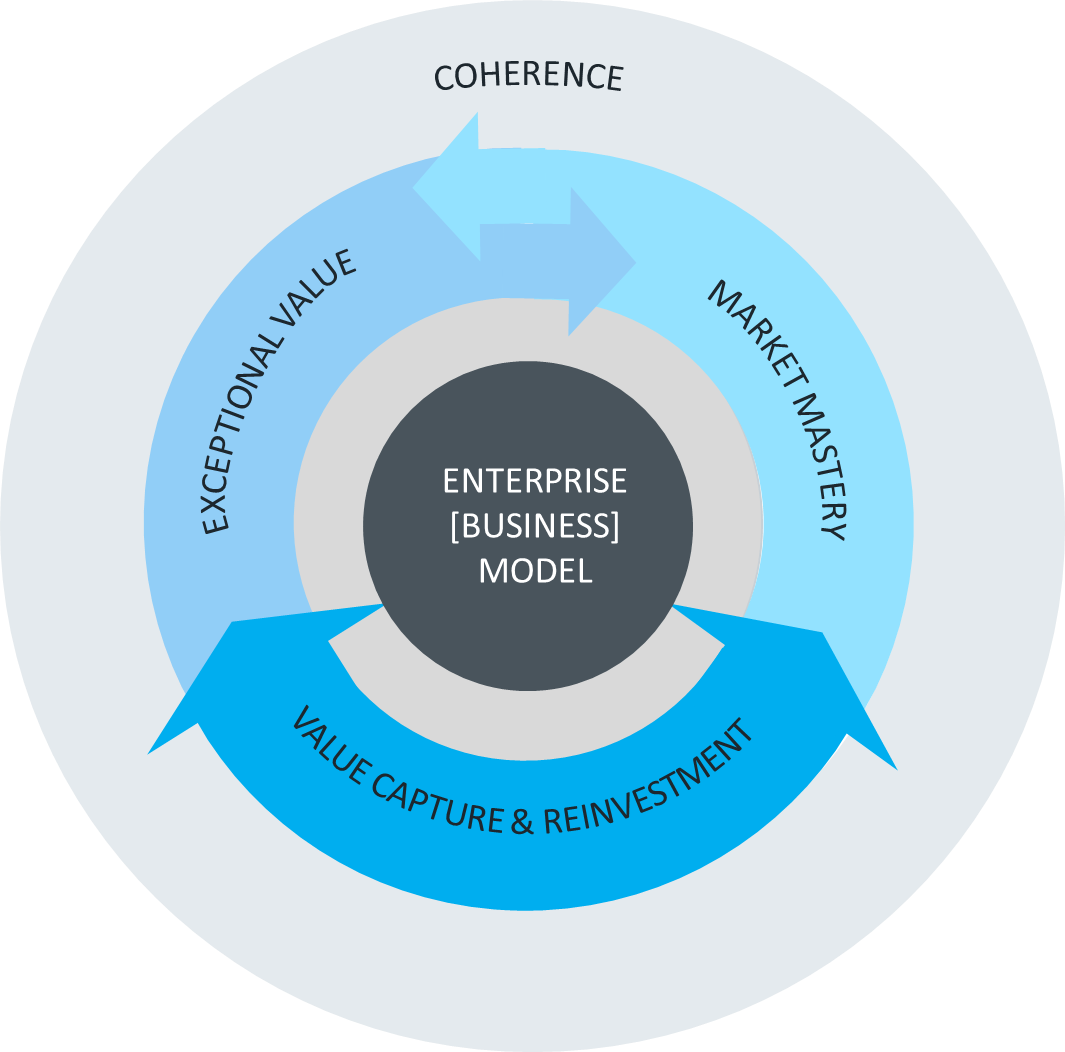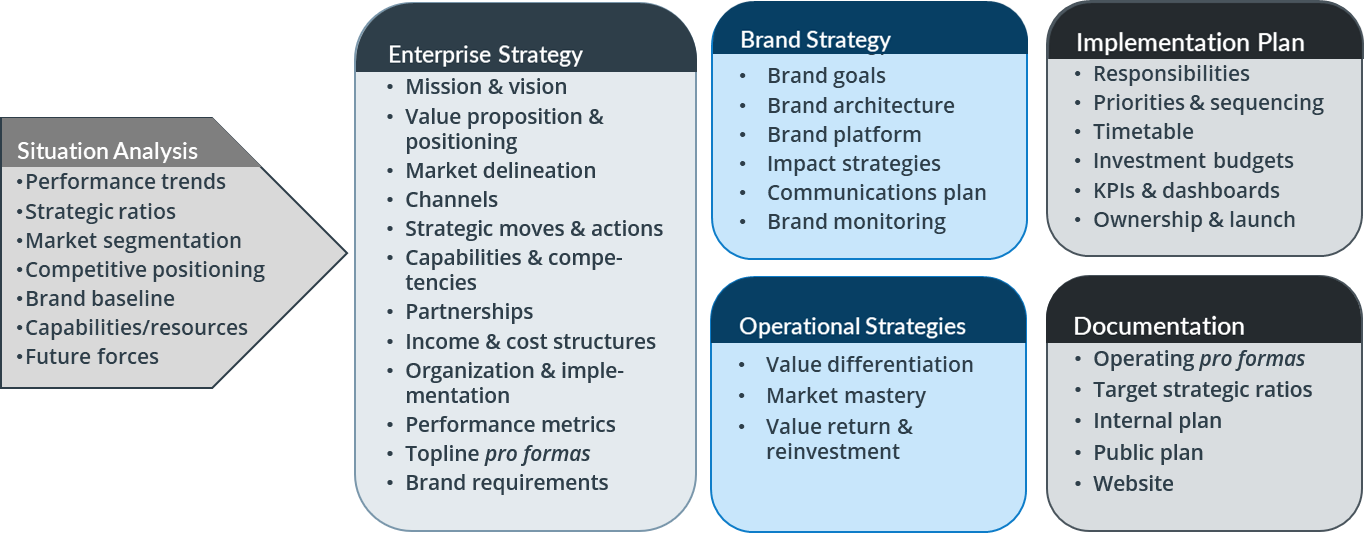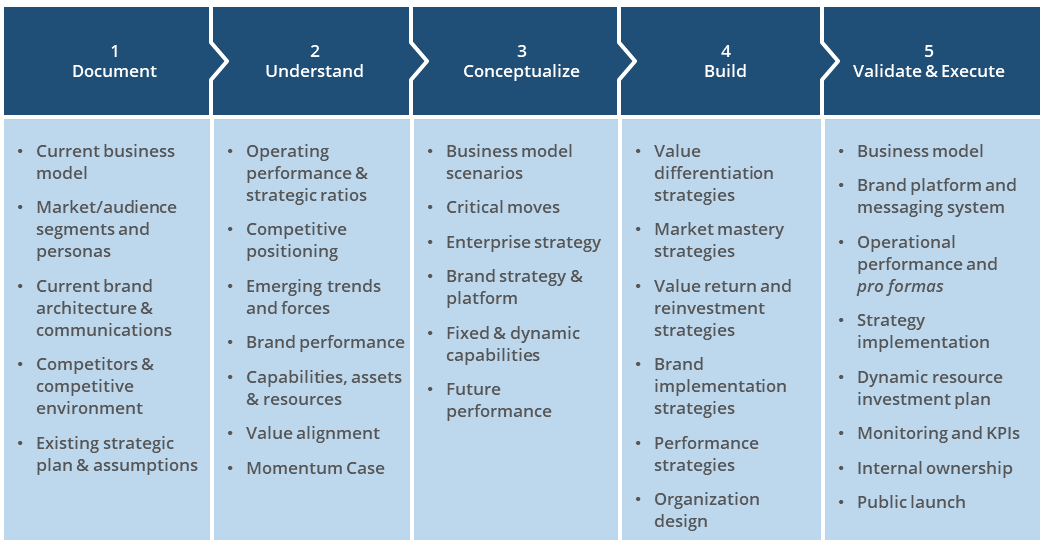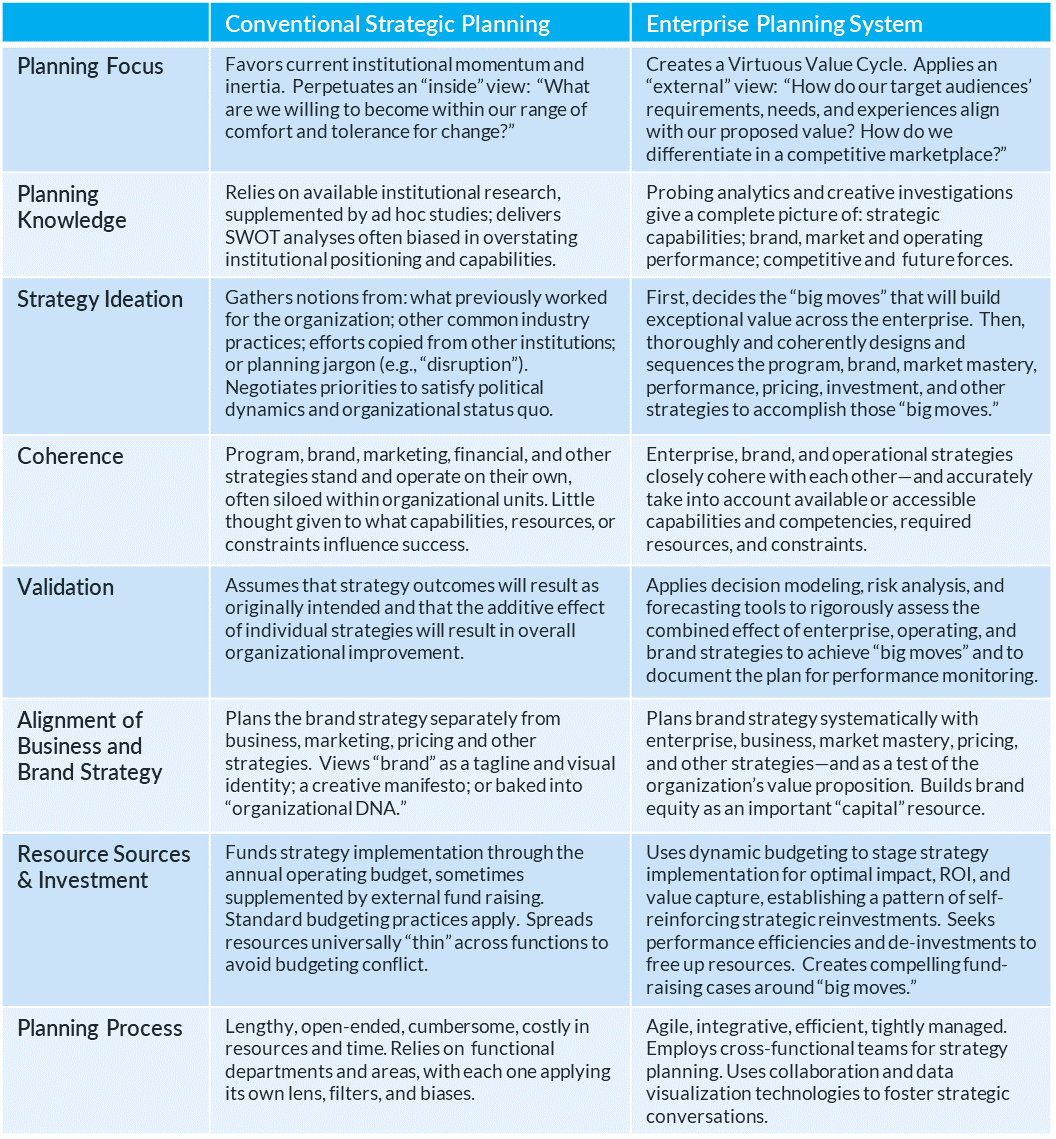
The Academic Enterprise Planning System is an agile process for designing a coherent set of business, brand, and performance strategies to differentiate an academic enterprise—university, college, school, division, or program—based on its exceptional educational value. Here’s how it works.
American education at all levels is in the midst of a powerful and turbulent sea change.
The intrinsic merit of our educational missions and programs is no longer assumed. Rather, our stakeholders—students, families, alumni, employers, donors and funders—are insisting that universities, colleges, and schools differentiate and demonstrate their value in an educational marketplace that has never been fiercer in competition and under greater public scrutiny. In order to thrive, forward-thinking colleges and schools must plan, operate, and communicate coherently and nimbly around exceptional value, with the conviction to make “big moves” to amplify their educational impact. We’ve created a planning system for these challenging new realities.
Prescience Associates innovates at the nexus of business strategy, brand strategy, and performance management for educational institutions. We helped pioneer strategic planning for higher education in the late 1970s, including specialties in scenario development and competitive strategy. In the early 1980s, we won national attention for our ground-breaking work that built brand strategy on cutting-edge opinion research and geodemographic market segmentation. Shortly thereafter, we added performance management to our capabilities, with an activity-based costing (ABC) and performance model for higher education, decision-modeling and risk-analyses techniques, and proprietary forecasting, performance metrics, and dashboarding tools. Our greatest value lies in the breadth of our experience, the depth of our expertise, and our spirit of inventiveness honed across some 300 successful engagements for academic enterprises.
The Value Imperative
When designing our planning system, we extensively researched what works in business strategy among enterprises that achieve a high rate of “economic value added” or return (EVA), a key measurement of strength and sustainability. We discovered that, regardless of industry, high-performing enterprises focus on what we’ve termed the “Virtuous Value Cycle” (Figure 1). They excel across three dimensions:
- Exceptional Value. High-performing enterprises are vigilant about creating and delivering exceptional value that is relevant to their audiences, springs from their missions and capabilities, and differentiates them among competitors. They work hard to understand what constitutes meaningful value from their audiences’ perspective, taking into account each segment’s requirements, needs, and constraints. They recognize emerging trends and forces and the resulting shifts in value, and they innovate novel value combinations that their audiences may not yet have anticipated.
THE SEVEN CHARACTERISTICS OF EXCEPTIONAL VALUE
- Born from Mission. Exceptional value manifests the enterprise’s mission, values, and purposes.
- Addresses Real Needs. Exceptional value comprehends and aligns with the known and emerging requirements and needs of its chosen audiences—and removes or mitigates barriers and constraints.
- Realizes Relevant Impact. Exceptional value results in benefits, improvements, and transformations meaningful for the persons, organizations, and communities the enterprise serves.
- Differentiates among Competitors. Exceptional value positively and perceptibly differentiates the educational enterprise among its competitors.
- Woven Throughout. Exceptional value is systematically designed throughout the educational enterprise’s offerings, delivery channels, pricing, user experiences, and culture.
- Delivers on Promises. Exceptional value is built upon a sufficient base of capabilities, competencies, and resources for dependability and reliability.
- Builds Equity. Exceptional value enlarges the enterprise’s visibility, reputation, and brand equity.
THE SEVEN CHARACTERISTICS OF EXCEPTIONAL VALUE
- Born from Mission. Exceptional value manifests the enterprise’s mission, values, and purposes.
- Addresses Real Needs. Exceptional value comprehends and aligns with the known and emerging requirements and needs of its chosen audiences—and removes or mitigates barriers and constraints.
- Realizes Relevant Impact. Exceptional value results in benefits, improvements, and transformations meaningful for the persons, organizations, and communities the enterprise serves.
- Differentiates among Competitors. Exceptional value positively and perceptibly differentiates the educational enterprise among its competitors.
- Woven Throughout. Exceptional value is systematically designed throughout the educational enterprise’s offerings, delivery channels, pricing, user experiences, and culture.
- Delivers on Promises. Exceptional value is built upon a sufficient base of capabilities, competencies, and resources for dependability and reliability.
- Builds Equity. Exceptional value enlarges the enterprise’s visibility, reputation, and brand equity.
- Market Mastery. They are expert in communicating differentiated value to their markets and audiences through well managed brand strategies and relationships. They enjoy healthy competition, carry out effective marketing, recruitment, and engagement programs, cultivate and defend their reputations, and relish opportunities to promote their value.
- Value Recapture and Reinvestment. They set pricing, financial, and performance policies to reflect their differentiated value. They effectively “recapture” superior economic and reputational value from their markets. Then they strategically and dynamically reinvest this recaptured value in programs, capabilities, and capital (including brand capital) of greatest strategic importance, rather than spreading their investments uniformly “thin” across all pursuits.
In addition to the Virtuous Value Cycle, we derived another important finding from our research. High-performing enterprises are guided by sound, formal enterprise or business models that thoroughly answer fundamental questions about what markets and segments they choose to serve and pursue, how they will create exceptional value for those markets, what channels they will use to reach those markets, what key capabilities, resources, partnerships, and activities will be required, and what revenue and cost structures are advantageous. Hence, before starting strategic and brand planning, they first design a “value architecture” in the form of a business model in order to enforce coherence throughout the planning process.
Figure 1
Virtuous Value Cycle

High-performing enterprises have a clear and compelling Enterprise (or Business) Model that lays out how they will create, communicate, and deliver differentiated value. They then agilely develop and execute a coherent set of strategies around Exceptional Value, Market Mastery, and Value Capture and Reinvestment. By strategically reinvesting in capabilities, capital, and resources that continuously enhance value and market mastery, they establish a Virtuous Value Cycle.
Designed to Meet the Needs of Universities, Colleges, Schools and Other Academic Enterprises
Prescience’s Academic Enterprise Planning System is designed to scale across various educational enterprises by type and size. We have applied our methods to successfully guide strategic and brand planning and performance management at:
- Research and doctoral universities
- Master’s and regional universities
- Liberal arts and baccalaureate colleges
- Special-purpose colleges and institutes
- Academic colleges, schools and divisions within a university
- Graduate, continuing education, and extended learning programs
- Private and independent secondary schools.
What matters most for the planning system’s success is the organization’s dedication to delivering and competing on outstanding differentiated educational value. No shortcuts or “silver bullets” to value allowed.
The Academic Enterprise Planning System: Designing and Delivering on Exceptional Value
Informed by the lessons of high-performing organizations, our planning system delivers six essential, tightly integrated planning components to design enterprise-level, business, brand, and performance strategies around exceptional value (figure 2).
Figure 2
Academic Enterprise Planning System Deliverables
A fully rationalized and tested Enterprise Strategy provides the “value architecture” for the academic enterprise, which, in turn, generates a Brand Strategy and a set of Operational Strategies. A thorough Situation Analysis establishes the knowledge and environment for planning. An Implementation Plan employs dynamic sequencing, scheduling, and budgeting techniques, as well as setting the KPIs and monitoring to keep the plan on track. The plan is fully documented, both with quantitative pro formas and through engaging “strategy storytelling,” a communications strategy, and a planning website.
1. Strategic Situation Analysis
To start, we complete a comprehensive strategic situation analysis that creates an evidence-based, shared understanding of:
-
- Important operating trends of recent performance in student and program enrollments, persistence, recruitment, fund raising, finances, capital investments, asset use, and the like;
-
- Key strategic and financial ratios that help determine organizational viability, room for maneuver, and strategic constraints;
-
- Segmentation schema for audiences and markets, along with performance assessment and value recapture analytics for each segment;
-
- Brand and program positioning among competitors, as well as comparative strengths and weaknesses and other competitive research;
-
- A brand audit and baseline based upon brand opinion research;
-
- An inventory of capabilities, competencies, and key resources and assets aligned to differentiated value and available for strategic growth; and
-
- Emerging environmental trends and future forces which influence planning opportunities and risks.
We can additionally customize the situation analysis to an enterprise’s specific planning needs, with specialized survey research, performance and market investigations, and benchmarking analyses. The situation analysis typically generates a “Momentum Case,” i.e., a forecast of what the academic enterprise would look like in terms of operations, competitive positioning, and brand performance if no changes were made to influence its current trendlines.
2. Enterprise Strategy
Next, a formal statement of Enterprise Strategy determines the “value architecture” for the academic enterprise. It represents the business model by which the college or school will conceptualize, design, deliver, and communicate differentiated value; what strategic actions and “big moves” it will need to make; what capabilities, resources, and partnerships will be required; how it will recapture sufficient value to reinvest in itself; and how it will organize and manage its performance. (See the outline below.) The Enterprise Strategy is a seminal document in our planning system, since it guides subsequent brand, operating, and performance strategies.
Scenario planning techniques can help generate the most compelling Enterprise Strategy. Alternative enterprise strategies are developed and placed alongside the “Momentum Case,” so that a college or school can assess different strategic pathways based upon its capabilities and resources and then determine which scenario optimizes the value cycle. We an apply decision modeling and forecasting tools to assist with choosing the best strategy option.
ORGANIZATION OF THE ENTERPRISE STRATEGY STATEMENT
- Mission, Values, and Vision: What is the enterprise’s educational mission, organizational values, and vision of the future?
- Value Proposition: How will the enterprise create meaningful, differentiated educational value through the nature and scope of its offerings and programs? Curriculum? Pedagogies and delivery? Learning relationships? Student or user experiences? Culture and setting? Pricing and accessibility? Other ways? Is the value proposition’s differentiation documented through competitive positioning?
- Market Delineation and Segmentation: Who are the targeted audiences, markets, and stakeholders? What are their requirements, needs, and constraints pertinent to value?
- Delivery and Communication Channels: How will value offerings be delivered? How will they be communicated and marketed?
- Strategic Actions: What “big moves” are required to achieve the strategy?
- Capabilities, Competencies, and Investments: What capabilities, competencies, and resources are required to achieve the strategy? What new capabilities are needed? What investments are necessary and how will they be funded?
- Partnerships and Relationships: What external partnerships, vendor relationships, and stakeholder groups are critical to success? How will they be cultivated?
- Income and Cost Structures: What are the major program and auxiliary revenue streams? How will offerings be priced and discounted? What are the principal costs of operations? Where can efficiencies and optimizations be realized?
- Implementation: How will the enterprise strategy be staged over time for optimal impact, return on investment, and sustainability, in light of available resources?
- Organization and Performance Metrics: How will the enterprise strategy be organized and monitored? What are key performance and outcome indicators and how will they be measured?
- Topline Pro Formas and Strategic Ratios: What will the enterprise look like under the strategy? What are critical operating forecasts? How will strategic ratios improve?
- Essential Brand Offerings: What are the strategy’s public offerings of value for each market segment? What are the brand requirements and principal brand messaging themes? How will the enterprise need to manage or adjust its visibility, brand, and reputation?
3. Brand Strategy
In a value-driven planning system, a proof point of a coherent enterprise strategy is whether a compelling brand strategy can be constructed to communicate differentiated value to targeted markets and audiences and to enhance visibility and reputation. A distinctive feature of our planning system is to immediately build the brand strategy, architecture, and communications alongside the enterprise strategy, so that they can creatively inform and cohere with each other, there is an understanding of what investments in brand will be required, and how brand performance goals will align with strategic and business goals around exceptional value. Our statement of brand strategy typically contains:
-
- Brand goals, or what the brand needs to accomplish in conjunction with the Enterprise Strategy (e.g., extend visibility, raise reputation, promote flagship offerings, engage stakeholders, enable premier pricing).
-
- Brand architecture of the master brand, hierarchy of secondary brands, brand extensions, and hybrid and endorsing brands.
-
- Brand platform, typically: a brand essence; brand message drivers; brand promise; brand characteristics, attributes, and benefits; personality traits; sample brand positioning; audience personas; essential offerings for key audience segments; and the brand messaging system.
-
- Brand and program positioning among competitors, as well as comparative strengths and weaknesses and other competitive research;
-
- Brand impact and communications strategies, or the strategies and activities to meet the brand goals and to effectively communicate the brand to its targeted audiences.
-
- An inventory of capabilities, competencies, and key resources and assets aligned to differentiated value and available for strategic growth; and
-
- Brand monitoring including methods and performance indicators to track improvements over the current brand baseline.
4. Operational Strategies
Our planning system requires the educational organization to thoroughly document the operational strategies that will achieve the Enterprise Strategy around:
-
- Exceptional Value:Existing programs; new offerings; curriculum design; instructional delivery; experiential learning; co-curricular offerings; the student experience; alumni and donor engagement; community engagement; scholarship and research; campus and technology; and the like.
-
- Market Mastery: Current market development; market expansion; new market growth; direct marketing and recruitment; retention and loyalty; pricing and discounting; and the like.
-
- Value Recapture and Reinvestment: Performance improvements; dynamic pricing; efficiencies and scale management; partnerships; external fund raising; capital and expenditure reallocations; improved return on assets; auxiliary enterprises; and the like.
Operational strategies are developed by cross-functional planning teams assigned according to the strategic actions and moves in the Enterprise Strategy. The strategy teams use a set of proprietary electronic templates to explicate their strategies. These templates can be assembled and “rolled up” into a master plan of operational strategies, so that decisions can be made about coherence, required resources, returns on investments, and implementation staging.
5. Implementation, Investment & Performance Plan
The Implementation, Investment, and Performance Monitoring Plan outlines:
-
- The priorities and sequencing of the Operating Strategies according to the implementation staging in the Enterprise Strategy and in order to return optimal returns and make use of available capabilities and resources.
-
- The investments that are required to carry out the Operating and Brand Strategies and the sources for those investments.
-
- The assignment of responsibilities for the Operating and Brand strategies within the organization, along with organizational changes to achieve the Enterprise Strategy.
-
- Key performance and outcome indicators (KPIs), metrics, and dashboards, along with the methods and schedule for monitoring and reporting on the Enterprise, Operating, and Brand strategies.
-
- The internal and public launches of the strategic plan, including strategies for how to foster internal understanding and ownership and how to communicate the plan externally among key stakeholders and partners and for philanthropic support.
We apply dynamic scheduling and budgeting techniques, using proprietary electronic templates, so that the academic enterprise can decision-model alternatives for sequencing strategies and forecast their results, as well as easily update and change timing, budgets, and outcomes according to performance and budget cycles and actual conditions.
6. Operating Pro Formas & Plan Documentation
A comprehensive set of operating and strategic ratio pro formas accompanies the plan, to model and forecast what the organization will look like over time as it achieves its Enterprise Strategy. These pro formas can be custom-designed in electronic templates to mirror the organization’s own reporting formats and protocols and to integrate with its information and data systems, so that they roll forward after each major performance and budget cycle.
We also assist with plan documentation and communications, for instance: materials for governance reviews and approvals; a final, comprehensive planning document; a “public” planning document; and a strategic plan website.
An Agile Planning Schedule
Our planning system iterates over five tightly organized phases (Figure 3), in order to agilely build the enterprise, brand, and operational strategies and implementation plan and metrics described above. Each phase asks crucial planning questions and applies methods and techniques that we know can effectively facilitate strategic conversations around those questions.
Figure 3
Five Phases of the Academic Enterprise Planning System
The Academic Enterprise Planning System is executed through five iterative, tightly designed planning phases. Each phase addresses the three domains of business, brand, and performance strategy, so that the resultant strategies are designed coherently according to an overarching enterprise or business model. High-impact planning techniques are incorporated into the planning system, such as audience segmentation schema and personas, brand baselining, scenario planning, and decision modeling and forecasting.
Our agile planning process is designed to efficiently concentrate an organization’s personnel, resources, and time though effective project management methods and technologies. While the complexity and time availability for each planning project are different—and we customize the planning phases accordingly—ideally, we can complete a strategic and brand planning program in around six work months.
BEST-IN-CLASS TECHNIQUES AND TOOLS
Over the past 25 years, we’ve assembled a toolbox of research, planning, and performance management techniques that can augment our planning system. They include:
- Opinion and brand survey research
- New program and market research
- Strategic ratio calculations & analyses
- Institutional and industry benchmarking
- Enterprise value canvas mapping
- Strategy storytelling
- Scenario planning
- Decision modeling and forecasting
- Decision risk analyses
- Activity-based costing (ABC) analyses
- Market and program life value analyses
- Performance dashboarding
Great strategy is both art and science: Compelling storytelling chronicles the organization’s horizons, vision, and future journey. Careful quantitative validation of the business strategies, capabilities, resources, and risks ensures the story has a happy ending.
BEST-IN-CLASS TECHNIQUES AND TOOLS
Over the past 25 years, we’ve assembled a toolbox of research, planning, and performance management techniques that can augment our planning system. They include:
- Opinion and brand survey research
- New program and market research
- Strategic ratio calculations & analyses
- Institutional and industry benchmarking
- Enterprise value canvas mapping
- Strategy storytelling
- Scenario planning
- Decision modeling and forecasting
- Decision risk analyses
- Activity-based costing (ABC) analyses
- Market and program life value analyses
- Performance dashboarding
Great strategy is both art and science: Compelling storytelling chronicles the organization’s horizons, vision, and future journey. Careful quantitative validation of the business strategies, capabilities, resources, and risks ensures the story has a happy ending.
Harnessing the Power of Coherence
Academic enterprises don’t have a “strategy generation” problem; universities, colleges, and schools have plenty of ideas about what to do to try to manage today’s highly-charged educational environment.
Rather, most have a coherence problem; program, brand, and performance strategies are disconnected from each other. This is often because academic organizations lack a clear enterprise or business model as to how they will design and deliver exceptional, differentiated value—and capture sufficient value in return.
The result is a lot of churning of talent, resources, and time in planning activities that fail to deliver the “big moves” that can propel success, as well as the execution and investments necessary to get there.
Figure 4 summarizes the key differences between conventional strategic planning programs and our enterprise planning system designed and built for coherence.
Figure 4
Comparison of Planning Models
Because we’ve intentionally designed our planning system to closely coordinate all steps for strategic, brand, business, and performance strategy, our clients benefit from the budget and time efficiencies of engaging with a single consulting firm and not having to repeat investigative, research, and planning investments when multiple planning processes or external consultants are used. This can result in savings of 25-30 percent over other planning programs that disassociate strategic, business, and brand research and planning.



